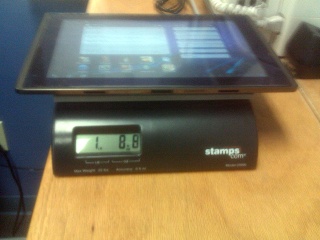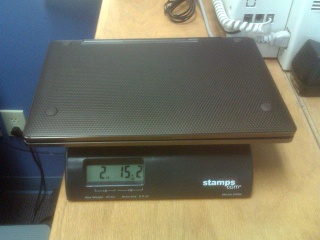
ASUS has entered the Android tablet market with a compelling new contender – the Eee TF-101 “Transformer.” Featuring an Nvidia Tegra dual-core CPU at 1.0GHz, the device feels “snappier” than most relatively high-end desktop PCs – nothing lags; when you open an app, it pops onto the screen smartly. If you’re accustomed to browsing on smartphones, you’ll feel the performance difference immediately – even notoriously heavy pages like CNN or ESPN render as quickly as they would if you were using a high-end desktop computer.
I first got my hands on a TF101 that one of my clients had purchased, sans docking station. After I’d played with it for a few minutes, I knew I wanted one, but that left the $150 question – what will it be like when it’s docked? The answer is “there’s a lot of potential here” – but there are problems to be worked through before you can give it an unqualified “hey, awesome!”
CNET complains that the TF101 feels cheap, with poorly-rounded corners and a flimsy backplate. After a week or so of ownership and something like 20 hours of active use, I do not agree on either issue. I find the tablet nicely balanced, easy to grip, and solid feeling. It weighs in at 1.6 pounds (tablet only) and 2.9 lbs (tablet and docking station), which puts it pretty much dead center in standard weight for both tablets and netbooks. However, while the weight of the docked TF101 is an ounce heavier than the weight of my Dell Mini 10v, the TF101 feels much less cumbersome – probably because even though it’s slightly heavier, it’s much, much slimmer.
Docking the tablet feels easy and intuitive; line up the edges of the tablet with the edges of the docking station, and you’re in the right position for the sockets to mate. Pressing down first gently, then firmly produces good tactile feedback for whether it’s lined up properly, and whether it’s “clicked” all the way in. The hinge itself is very solid and doesn’t feel “loose” or sloppy at all – in fact, it’s stiff enough that most people would have trouble moving it at all without the tablet already inserted. Undocking the tablet is easy; there’s a release toggle that slides to the left (marked with an arrow POINTING to the left, which is a nice touch); the release toggle also has a solid, not-too-sloppy but not-too-stiff action.
The docking station offers more than just the keyboard. There are also two USB ports (a convenience which is missing on the tablet itself), a full-size SD card slot, and an internal battery pack, roughly comparable to the battery in the tablet itself. The extra battery life is a great feature; the tablet itself gets 9 hours or so of fully active use, and the docking station roughly doubles that. In practical terms, most people will be able to go away for a long weekend with a fully-charged TF101 sans charger, use it for 4 hours a day without ever bothering to turn it off, and come home with a significant fraction of the battery left – especially if they’ve taken the time to set the “disconnect from wireless when screen is off” option in the Power settings. I used the docked tablet 2 to 4 hours a day for a full seven-day week, playing games, emailing, and browsing; at the end of the week I was at 15% charge remaining.

Polaris Office, the office suite shipped with the TF101, was a pleasant surprise – a client asked if I could display PowerPoint presentations on the tablet, and the answer turned out to be “yes, I certainly can.” I’ve only tried a few of them, none of which had any particularly fancy animations; but 40MB slideshows load and display just fine. Paired with an HDMI projector, the TF101 should make a pretty solid little presentation device, particularly since it feels just as “fast” running slideshows as it does browsing and playing games from the Market.
Moving on to the docking station itself, I quite liked the way the touchpad is integrated into the Android OS – instead of an arrow cursor, you get a translucent “bubble” roughly the size of a fingertip press, which felt much more intuitive to me. With the arrow, I tend to try to be just as precise as I would with a mouse – which can be frustrating. The “fingertip bubble” made it easier for me to relax and just “get what you want inside the circle” without trying to be overly finicky. Sensitivity for both tracking and tapping was also very good; the touchpad feels slick and responsive to use.
The keyboard, unfortunately, is a mixed bag – it’s better-suited to large hands than many netbook keyboards, but you won’t ever mistake it for the full-size keyboard on your desk. The dimensions are almost exactly the same as the keyboard on my Dell Mini 10v; but I find that it feels significantly more cramped and awkward – probably because ASUS elected to go the trendy new route of “raised keys with space between them”, where the Mini’s keys are literally edge-to-edge with one another. This should make the TF101 less likely to collect crumbs, skin flakes, and other kinds of “yuck” than the Mini 10v, but I personally would rather deal with more cleaning than less roominess.
Several applications don’t really play well with the keyboard – ConnectBot, which I use as an SSH client to operate remote servers, becomes completely unusable due to handling the shift key wrong – you can’t type anything from ! through + without resorting to re-enabling the onscreen keyboard. In the Android Browser, typing URLs in the address bar works fine, but if you do any significant amount of typing in a form – for example, writing this post in the TinyMCE control WordPress uses – the up and down arrow keys frequently map to the wrong thing. Sometimes up/down arrow would scroll through the text I was typing, sometimes they would tab me to different controls on the page, and some OTHER times they would simply scroll the entire page up and down.
In Polaris Office (the office suite shipped with the TF101), the keyboard itself worked perfectly – but the touchpad was too sensitive and placed too closely. It was difficult to type more than one sentence at a time without the heel of my hand brushing the touchpad and registering as a “tap”, causing the last half of a sentence to appear in the midst of the sentence before it.
Can these problems be mitigated? Probably. The ConnectBot issue was solved pretty simply by Googling “connectbot transformer”, which immediately leads you to a Transformer-specific fork of ConnectBot – after uninstalling the original ConnectBot, temporarily enabling off-Market app installation, and downloading and installing the fork directly from GitHub, my shift-key problems there were solved. Presumably either Google or ASUS will eventually deal with the arrow key behavior in the Android Browser. I tried using the Dolphin HD Browser in the meantime, but had no better luck with it – it is at least consistent in how it handles arrow key usage, but unfortunately it’s consistently wrong – it always scrolls the entire page up and down when you press up or down arrow keys, no matter where the focus on the page is. Finally, you can toggle the touchpad completely on or off by using a function button at the top of the keyboard – but it would be nice to simply change the sensitivity instead, or automatically disable it for half a second or so after keypresses, the way you can on a traditional (non-Android) netbook.
In the end, though, you can’t really fix all the problems by yourself with “tweaking”; some of the frustrations with the poor integration of the physical keyboard into the Android environment are going to keep ambushing you until Google itself addresses them. ASUS and individual app developers can and likely will continue working to mitigate these issues, but it will be a never-ending game of whack-a-mole until Android itself takes adapting to the “netbook” environment more seriously.
Final verdict: The tablet looks, feels, and performs incredibly well; in most cases it “feels faster” than even high-end desktop computers. Even though my Atom-powered Dell Mini 10v has a Crucial C300 SSD (Solid State Drive), the TF101 spanks it thoroughly in pretty much every performance category possible and sends it home crying. Battery life is also phenomenal, at 9-ish active hours undocked or 18-ish hours docked. It looks and feels, on first blush, like it would make a truly incredible netbook when docked – but Android 3.2 and its apps clearly haven’t come to the party well-prepared for a physical keyboard – and it shows, which knocks the initial blush well off the device as a netbook competitor. If you really need physical keyboard and conventional data entry, this is probably not going to be the device for you – at least, not until the rest of the OS and its apps evolve to support it better.
If you want a tablet, I can recommend the TF-101 without reservation. If you want a netbook, though, you should probably give the TF-101 a pass unless and until Google starts taking the idea of “Android Netbooks” seriously.